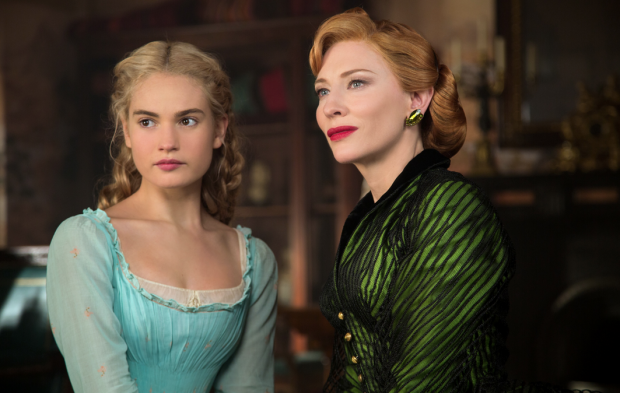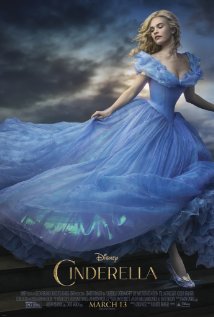Disney is once again, after a reasonable hiatus, back in the business of princesses. Since the studio’s surprise success and subsequent exploitation of Frozen, the Mouse House seems destined to resurrect all their classic animated female characters in a manner resembling Marvel’s superhero line-up. After the empty and muddled special-effects spectacles that were Alice in Wonderland and Maleficent, the proposition of a new version of Cinderella wasn’t so enticing.
Never mind that the all-too-familiar story has been excessively and aggressively mined all across pop-culture; the original 1950 Disney version isn’t quite the classic it’s reputed to be, paling next to the likes of Snow White, Sleeping Beauty and Beauty and the Beast. It was an interesting choice, to say the least, when Kenneth Branagh was brought in to helm the film, and watching the final product, it becomes clear that Disney was hoping that he’d be able to do for their princesses what he managed for the more fantastical Marvel superheroes in 2011’s Thor.

For better or worse, Branagh has redefined the template for what Disney’s princess franchise will look like going forward, and the most surprising thing is how traditional and classically coiffed it turns out to be. I was not in the market for another Cinderella movie, but the new film is relentlessly charming and it works hard to win over skeptics. This is not done with fresh bells and whistles or even a more progressive take on what has always been a rather archaic story, but with good old-fashioned movie-making that takes its source at face value and then furnishes it with some of the loveliest visual design we’ve seen on film this year.
Although Branagh’s approach to Marvel’s Norse god of Thunder was to renovate his somewhat dated macho-man image and anchor his mythological world with the reality of ours, the director and his team take the opposite tact with the Brothers Grimm’s hygienically challenged housekeeper. This Cinderella is not a playful, female-empowered riff on the story like 1998’s endearing Ever After, but a mostly faithful live-action retelling of the Disney animation, including the anthropomorphic mice and grumpy cat Lucifer. It is not much interested in the real world at all—neither in its visual or psychological furnishings—and instead translates us into the cartoon’s headspace, while adapting its two-dimensional fancies into an exquisitely textured sensory universe. As a viewer, you will either be inclined to resist such a familiar rendering of a tired story, or go along for Branagh’s ride which tells this particular version of the tale about as well as it can, improving upon its predecessor as it goes.
The first bit of magic happens in the casting, and then in the way Branagh applies his Shakespearean theatrical sensibilities to capturing their performances. Played with bright-eyed openness and earnest kindness by Downton Abbey’s Lily James, this Cinderella may not be as self-possessed as we’d like, but she makes up for it with a legitimate sweetness that actually energizes the film’s too-easy motto of “have courage and be kind.” This complete dedication to evoking goodness while yearning for more is essential in the early going, when young Ella finds herself at the mercy of her imperious (and, yes, quite wicked) stepmother (Cate Blanchett) and her two mewling daughters (Holliday Grainger and Sophie McShera) who take self-involvement and turn it into complete social blindness. Some parents may worry about Ella’s somewhat passive role in her own story, as well as the way everything is seemingly fixed by the appearance of a prince, but Branagh keeps his film entwined with a fairytale sensibility that emphasizes kindness over meekness, even when Chris Weitz’s script can’t always see the way forward.

The story plays out exactly as you remember—with a minor tweak here or there—but with so many generous details that we are inclined to sit back and just soak it up on a superficial level. One of the great pleasures then is Blanchett’s stepmother, who doesn’t fit easily into Branagh’s confluence of 18th century manners and medieval fantasy, but brashly carves out her own space, never quite making up her mind if she’s in a 40’s era noir or a 40’s era comedy. Whether leaning dramatically over a spiral-staircase in a manner worthy of Ingrid Bergman or staring out from the shadows with the vampy relish of Bette Davis, Blanchett is completely in tune with the fact she’s playing an idea—a representation of evil—and not exactly a human being, but she also offers morsels of humanity that delightfully ground her when she’s confronting her put-upon stepdaughter. The costume designers have wrapped her up like a emerald green vision of malice, embellished and emphasized by that icy crystal glare; many of the best scenes are acted completely by Blanchett’s eyes. If the movie ultimately lacks for drama, it may be due to its inability to carve out a bigger emotional space for Cinderella’s spiteful step-mommy.
Not that anyone really gets much definition beyond their iconographic positions in the story. It’s less about who they are, than how they make us feel as the tale unfolds. So Helena Bonham Carter’s fairy godmother isn’t really interesting except for the incongruous whimsy she brings to finding the right vegetable to turn into a coach, and Derek Jacobi’s ailing king may be best summarized by the affectionate wisdom that shines on his face when he considers his son’s future. This kind of shallow but direct identification is most obviously felt in regards to Richard Madden’s prince, but Madden brings a youthful vigor and sensitivity that works. He may not redefine the character but he does provide some earned charm to this prince charming. Grainger, McShera and Stellan Skarsgaard mostly fade into the background, but Branagh does give them all a few moments to shine. I’m consistently intrigued by Nonso Anonzie, who seems to have the unfortunate luck of always playing a servant, captain-of-the-guard, instructor or henchman without ever getting to take center stage. I’d be more interested in seeing Anonzie take on, say, Othello, than watching another princess movie.

It’s an understatement to say that Cinderella looks great; this film’s real fairy godparents come in the form of costume designer Sandy Powell, production designer Dante Ferretti and cinematographer Haris Zambarloukos. Like Paddington earlier in the year, Cinderella takes its pedigree as a children’s fable and has a lot of fun with twisting and turning the natural order of things into an appealing aesthetic that walks the world of dreams. From Ella’s drafty, expansive attic that smacks of harrowing German Expressionist angles to the lavish, sprawling ballroom of the palace, there’s not a space in this film that looks under-developed or designed. Branagh’s direction is also key, placing the actors in all the right places, and allowing cameras to glide in ways to accentuate both performer and prop. He also doesn’t mire the film in excessive CGI, withholding most of that visual wizardry for the delightful scene where Cinderella’s coach and company turn back into the pumpkin and farmhouse creatures they really are.
It’s an enjoyable film and I appreciated its indulgent energy and cheerfully old-school approach to the drama. When so many action movies hastily botch their big set-pieces, or comedies busily hurtle past their planned punch-lines, it’s refreshing to see a film like this one actually lovingly linger during its own version of event-movie essence; the first dance at the ball between Ella and the prince. So much of Cinderella is so good as to make one wonder what might have been were it not so faithfully tied to its Disney tradition. Ultimately though, this Cinderella holds enough magic to transfix us, and if most of its lasting effect will evaporates before the stroke of midnight, it’s still quite enchanting in the moment.
Cinderella opens in wide release on Friday, March 13th.

